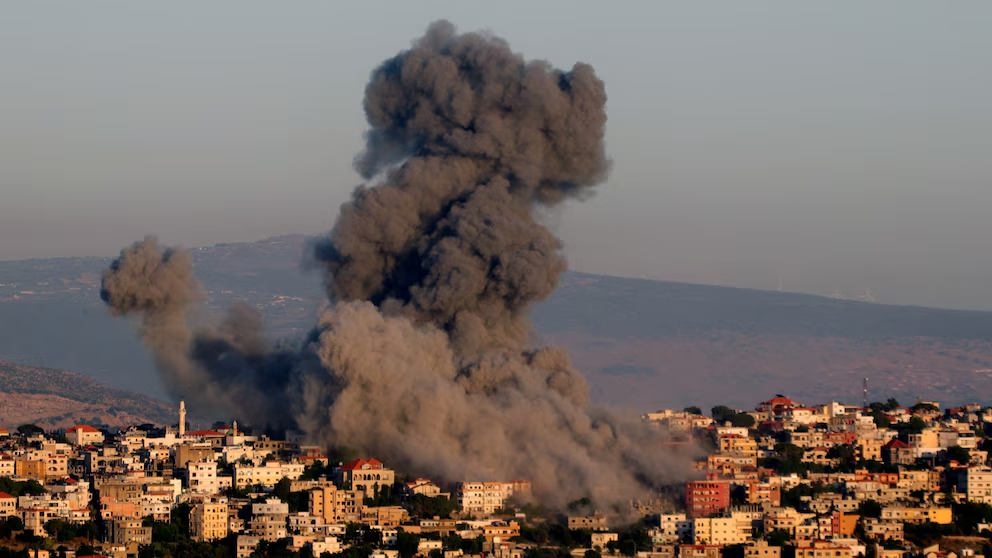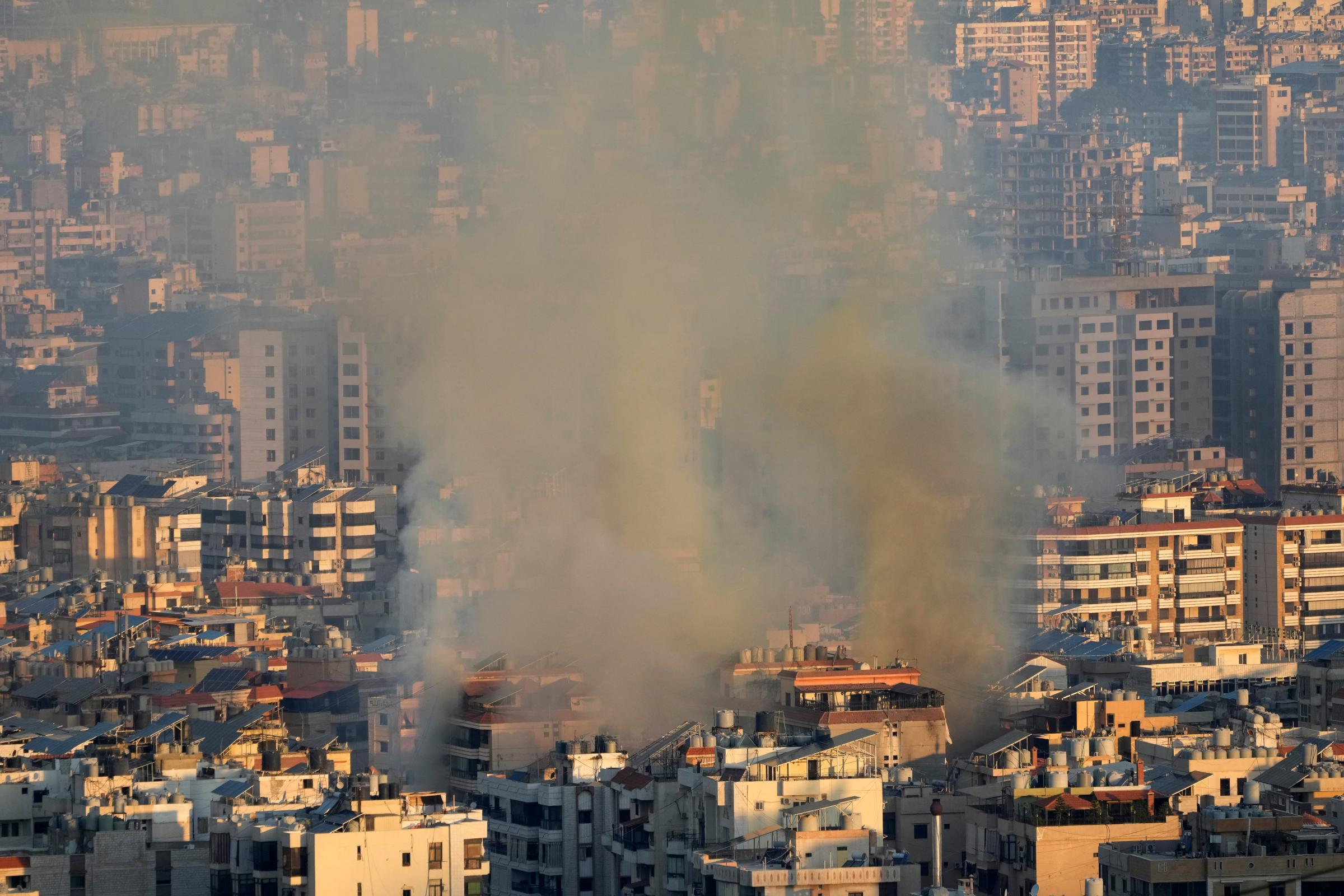Beirut, the capital of Lebanon, experienced a devastating blow on Friday when Israeli airstrikes targeted Hezbollah’s headquarters, reducing multiple high-rise apartment buildings to rubble.
This marked one of the most significant blasts in the city over the past year. The explosions not only shook the heart of the city but also escalated tensions between Israel and Hezbollah, bringing the region closer to the brink of full-scale war.
The series of explosions took place in Haret Hreik, a densely populated Shiite district of Beirut’s Dahiyeh suburbs. At least six people lost their lives, and over 91 were injured in the strike, according to Lebanon’s health ministry.
Rescue efforts are ongoing, with authorities expecting the death toll to rise as they continue to search through the debris. The blasts left a haunting image of destruction in the city, with entire buildings leveled and civilians fleeing in panic.
Hezbollah’s Headquarters Targeted in Beirut
The focus of the airstrikes was Hezbollah’s underground headquarters, located beneath residential buildings in the southern suburbs of the city. According to the Israeli military, the target of the strike was the militant group’s leader, Hassan Nasrallah.
Read : Hezbollah Fires Missile at Israeli Spy Agency Mossad, Israeli Strikes Back
While it is still unclear whether Nasrallah was present at the time of the attack, sources familiar with the operation confirmed that he was the intended target. Despite these claims, Hezbollah has yet to issue a public statement regarding the strike or the whereabouts of its leader.
Israel’s airstrikes in the city were part of a broader military campaign aimed at crippling Hezbollah’s operations in Lebanon. Over the past two weeks, Israel has intensified its strikes on Hezbollah-controlled areas, further heightening tensions between the two adversaries. Israeli military spokesperson Rear Adm.
Daniel Hagari confirmed that the strikes in the city were designed to dismantle Hezbollah’s underground command centers, which were believed to house critical weapons and personnel.
Beirut, a city already scarred by years of conflict, now finds itself at the epicenter of this latest confrontation. The magnitude of the explosion in the densely populated district sent shockwaves throughout the city.
⚡️#Israel airstrike reportedly targeted #Hezbollah official Nabil Qaouk, a senior member of the group's Executive Council. The attack damaged a building in Dahieh, Southern Beirut, #Lebanon resulting in multiple civilian injuries and deaths. pic.twitter.com/ykRPnvNb4f
— Intel Sentinel (@IntelSentinel_) September 28, 2024
Footage circulating on social media and local news outlets captured the immediate aftermath, showing thick plumes of black and orange smoke rising into the sky. Buildings that once stood tall were reduced to dust, leaving behind massive craters and piles of twisted metal.
Impact on Beirut’s Civilians
The impact of the strikes on Beirut’s civilian population has been severe. Hundreds of residents in the Haret Hreik district have been displaced, forced to flee their homes amidst the chaos.
The blasts not only destroyed the physical infrastructure but also tore through the lives of families who lived in the now-destroyed apartment buildings. the city has seen its share of tragedy over the years, and this latest attack adds another layer of suffering for the people of the city.
Rescue teams in Beirut continue to work around the clock, pulling survivors from the rubble and transporting the injured to nearby hospitals.
The chaotic scenes of destruction have overwhelmed local hospitals, which are struggling to manage the influx of patients. Emergency responders have described the situation in the city as dire, with many residents still trapped under the debris of collapsed buildings.
🇮🇱🔥🇱🇧 By far the largest bombing in Beirut until now, some sources mention 15-20 bombs.
— ADN Messenger / All Disruptive News. (@ADN_Mensajero) September 27, 2024
At least four appartment buildings have been completely flattened in Beirut. pic.twitter.com/ZVRxmTd68Z
Beirut’s citizens are no strangers to conflict, but the scale of this latest attack has left many in shock. The city has long been a flashpoint in the ongoing struggle between Israel and Hezbollah, and Friday’s strikes mark one of the most significant escalations in recent years. With multiple residential buildings destroyed, the residents of the city now face an uncertain future as the conflict shows no signs of abating.
Beirut on the Edge of Full-Scale War
The bombings in the city have further stoked fears of a full-scale war between Israel and Hezbollah. The volatile situation in Lebanon has deteriorated rapidly in recent weeks, with both sides trading strikes and escalating rhetoric.
the city, once known as the “Paris of the Middle East,” is now at the forefront of this escalating conflict, with its civilians caught in the crossfire.
Following the strikes in the city, Israeli Prime Minister Benjamin Netanyahu cut short his visit to the United States to return home and oversee the military campaign.
In a speech delivered earlier at the United Nations, Netanyahu vowed that Israel’s efforts to dismantle Hezbollah’s military capabilities would continue. His comments further dimmed hopes for a cease-fire or diplomatic resolution to the conflict.
As the conflict intensifies, the city remains a focal point of the ongoing military operations. The Israeli military confirmed that it had warned residents of three buildings in Beirut’s southern suburbs to evacuate before launching a new round of strikes early Saturday.
The buildings, according to Israeli sources, were being used by Hezbollah to store weapons, including advanced anti-ship missiles. Despite these warnings, the risk to civilians in Beirut remains alarmingly high.
The potential for further escalation in Beirut looms large, with both Israel and Hezbollah showing no signs of backing down. For the people of Beirut, this means living in constant fear of the next airstrike, as the city continues to bear the brunt of the conflict.
The destruction of high-rise buildings and the loss of civilian life are tragic reminders of the toll this conflict is taking on the city’s population.
The International Response to Beirut’s Crisis
The international community has expressed deep concern over the situation in Beirut, calling for restraint and urging both sides to avoid further escalation. However, diplomatic efforts to de-escalate the conflict have so far been unsuccessful.
The sheer scale of the destruction in Beirut has drawn condemnation from human rights organizations, who warn that the civilian population is bearing the brunt of the violence.

Richard Weir, a crisis and weapons researcher with Human Rights Watch, stated that the blasts in Beirut were consistent with the use of “Bunker Buster” bombs, powerful munitions designed to penetrate underground targets.
These bombs, made in the United States, have the capacity to level entire city blocks, as seen in the aftermath of the Beirut strikes.
The use of such devastating weaponry in densely populated urban areas like Beirut has raised serious concerns about the humanitarian impact of the conflict.
As rescue efforts continue in the city, the full extent of the damage is still being assessed. The people of Beirut now face a long and difficult road to recovery, with many left homeless and grieving for lost loved ones.
Beirut’s Uncertain Future
For Beirut, a city already scarred by years of war and political instability, the future remains uncertain. The recent strikes have plunged the city into a new chapter of violence, with no clear end in sight.
The destruction of Hezbollah’s headquarters in Beirut may have been the immediate objective of the Israeli strikes, but the long-term consequences for the city and its residents are far-reaching.
As Beirut grapples with the aftermath of the bombings, the city’s resilience will once again be put to the test. The people of Beirut have endured hardship before, and they will likely need to do so again in the face of this latest crisis.
However, the question remains: how much more can Beirut endure before the city is pushed to its breaking point?
The ongoing conflict between Israel and Hezbollah has turned Beirut into a battleground, and the impact on its civilians is devastating.
The city’s residents are now left to pick up the pieces of their shattered lives, hoping for a future where peace is once again possible in the Lebanese capital. Until then, Beirut remains a symbol of both resilience and tragedy, as the world watches anxiously for what comes next.
let’s enjoy few years on earth with peace and happiness….✍🏼🙏


Can you be more specific about the content of your article? After reading it, I still have some doubts. Hope you can help me.
Thanks for sharing. I read many of your blog posts, cool, your blog is very good.
I don’t think the title of your article matches the content lol. Just kidding, mainly because I had some doubts after reading the article.
Your point of view caught my eye and was very interesting. Thanks. I have a question for you.
I don’t think the title of your article matches the content lol. Just kidding, mainly because I had some doubts after reading the article.
Thank you for your sharing. I am worried that I lack creative ideas. It is your article that makes me full of hope. Thank you. But, I have a question, can you help me?
Your point of view caught my eye and was very interesting. Thanks. I have a question for you.
Your point of view caught my eye and was very interesting. Thanks. I have a question for you.
Thanks for sharing. I read many of your blog posts, cool, your blog is very good.
Your point of view caught my eye and was very interesting. Thanks. I have a question for you.
Your article helped me a lot, is there any more related content? Thanks!
Thank you for your sharing. I am worried that I lack creative ideas. It is your article that makes me full of hope. Thank you. But, I have a question, can you help me?
Your point of view caught my eye and was very interesting. Thanks. I have a question for you.
I don’t think the title of your article matches the content lol. Just kidding, mainly because I had some doubts after reading the article.
Thank you for your sharing. I am worried that I lack creative ideas. It is your article that makes me full of hope. Thank you. But, I have a question, can you help me?
Can you be more specific about the content of your article? After reading it, I still have some doubts. Hope you can help me.